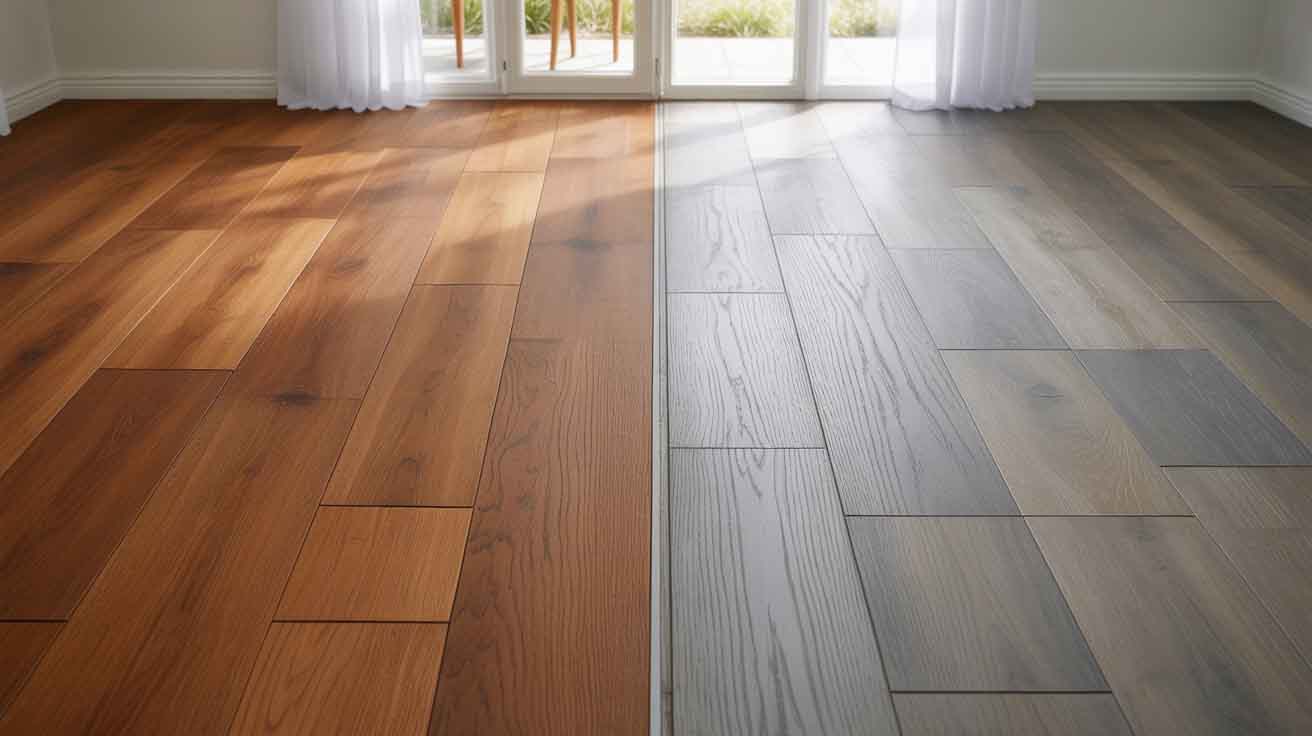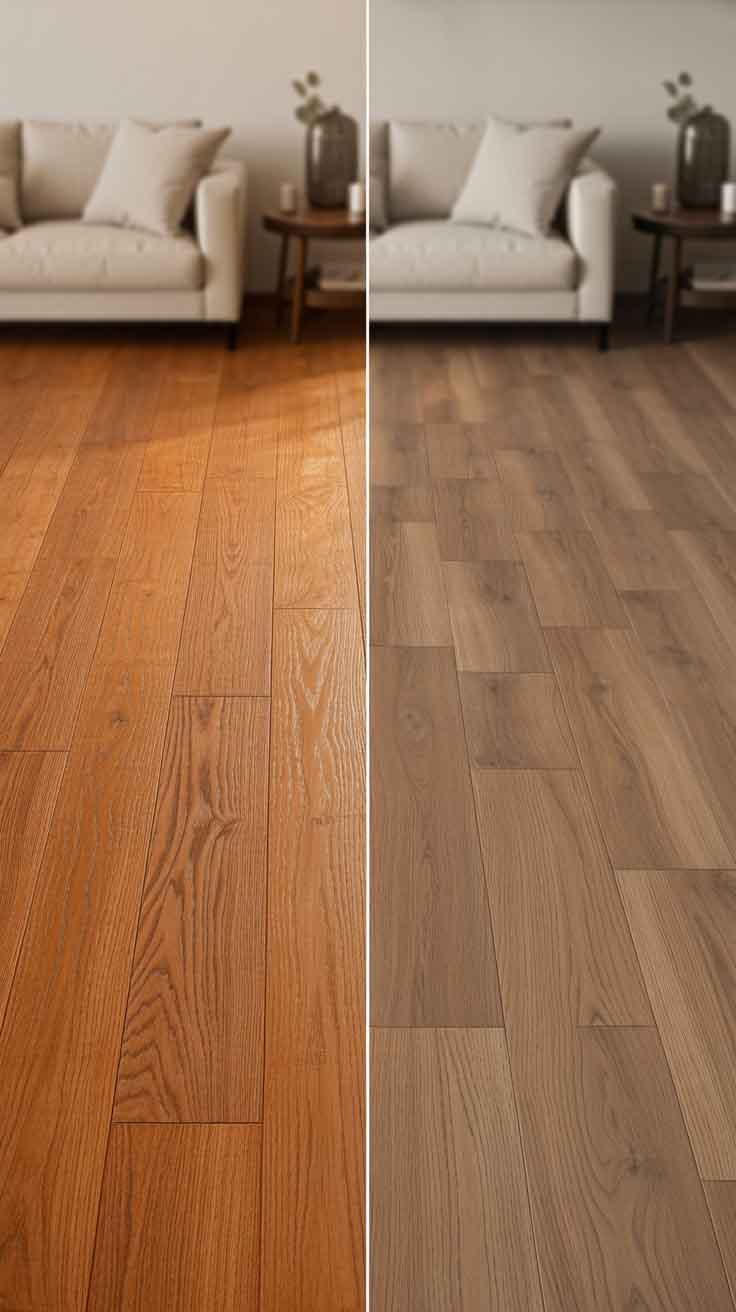The Modern Solution: Engineered Wood Plank
What it is: Engineered wood is a floorboard made from multiple layers bonded together under extreme heat and pressure. Think of it like high-tech plywood with a stunning wooden top layer.
The structure has three parts:
-
Wear Layer (Top): This is a relatively thin slice of real, premium hardwood (the oak, maple, or walnut you see). This is the part that gives it its look and feel.
-
Core (Middle): This is the game-changing element. It consists of multiple cross-plies of wood or wood composites (like plywood or HDF) stacked perpendicular to each other.
-
Back Layer (Bottom): A stabilizing wood veneer that balances the board.
Construction and Response to Moisture
The primary strength of engineered wood is its multi-ply core. By stacking the layers with the grain running in opposing directions, the overall structure of the board is highly resistant to movement. When one layer attempts to expand width-wise due to moisture, the layer perpendicular to it works to hold it steady. This dimensional stability is why engineered plank is a superior choice for humid climates. Its moisture resistance is excellent.
In Florida, where moisture can come from below (a concrete slab) and above (the air), the stability of engineered wood provides a protective barrier against the warping and twisting that plagues solid wood. It tolerates wider humidity fluctuations and is far more forgiving if your air conditioning system fails or if you decide to leave the AC set high during a long trip.
Pros of Engineered Plank:
-
✅ Superior Dimensional Stability: The cross-ply core dramatically minimizes expansion and contraction, making it ideal for high-humidity environments.
-
✅ Installation Versatility: It can be nailed, glued, or floated (free-laying the floor over a specialized underlayment). This allows for direct installation over concrete slabs, which is essential for most Florida homes. This is a much easier, less complex installation process.
-
✅ Suitable for Below-Grade: Can be safely installed in basements or rooms slightly below the exterior ground level.
-
✅ Efficiency: The use of a real wood top layer means you get the authentic look without needing to use as much old-growth timber.
-
✅ Wider Plank Availability: Due to its stability, engineered wood is readily available in the wider plank sizes that are popular in modern design trends.
Cons of Engineered Plank:
-
✅ Limited Refinishing: While the top layer is real wood and can be refinished, it can only be done once or perhaps twice, depending on the thickness of that top wear layer. Its lifespan of 30-50 years is less than that of solid hardwood.
-
✅ Look-Alikes: There are poor-quality versions on the market with extremely thin veneers and cheap cores. You must choose a reputable supplier and installer like AJS Renovations to avoid inferior products.
The Decision Point: Performance in a Florida Home 🌡️
When comparing the two options specifically for a Florida home, where moisture and heat are constants, the differences in performance become critically apparent. The material that manages moisture most effectively will always be the winner here.
Moisture Resistance: Solid hardwood has poor moisture resistance and is highly prone to cupping and crowning when the humidity spikes. Engineered plank, thanks to its cross-ply core, has excellent dimensional stability that resists movement, making it the clear winner for moisture management.
Installation Over Concrete: For a Florida home with a concrete foundation, installation over a slab is a key consideration. Solid hardwood installation over concrete is very difficult, requiring a complex, expensive subfloor and vapor barrier system. Engineered plank, conversely, is an easy installation, as it can be glued directly to the slab using a robust moisture barrier adhesive. For this reason, AJS Renovations almost always recommends Engineered Plank for installations over concrete.
Long-Term Durability: The main trade-off is long-term lifespan. Solid hardwood can be sanded 5-7 times and can last a century. Engineered plank can typically be sanded only 1-2 times, lasting 30-50 years. If the home environment can be strictly controlled for humidity, Solid Hardwood has the theoretical edge in longevity. However, given the environment, Engineered Plank offers better value for its performance, as its material and installation costs are mid-to-high, whereas solid hardwood is generally higher.
Humidity Tolerance and Installation Speed: Solid hardwood requires precise, consistent indoor humidity (40-60%) to prevent issues. Engineered plank is much more forgiving and tolerates wider fluctuations. Additionally, engineered plank has a Faster installation speed because it requires less acclimation time and has simpler subfloor requirements compared to the slower, more complex installation of solid hardwood.
The Final Verdict: Why Engineered Plank Wins in Palm Beach
For the vast majority of homeowners in Palm Beach, West Palm Beach, and Jupiter, engineered plank flooring is the practical, safer, and longer-lasting choice.
The primary reason is simple: Dimensional Stability.
The stability of the engineered core manages the expansion and contraction caused by our variable climate and the inevitable presence of moisture vapor rising from the concrete slab.
Choosing a high-quality engineered plank means you get the beautiful, authentic look of real wood while avoiding the headaches that come with solid wood in a perpetually humid environment. This choice allows you to worry less about your floors and more about enjoying the Florida lifestyle.
Making the Right Choice: Key Considerations
When talking to your renovation contractor, here are the three questions you must ask to ensure you pick the perfect product:
1. What is the Thickness of the Wear Layer?
The wear layer is the real wood veneer on top. This dictates how many times the floor can be sanded.
-
A layer of 1 mm to 2 mm is typically considered non-refinishable. It is meant for floors that will be completely replaced when the finish wears down.
-
A layer of 3 mm or more allows for at least one full refinishing, giving the floor a potential lifespan similar to many solid wood floors (30-50 years). AJS Renovations often recommends products with a thicker wear layer for maximum longevity.
2. What is the Core Material?
High-quality engineered plank uses a cross-ply Baltic birch plywood core. This dense, multi-layered core offers the best resistance to moisture and provides a rigid, stable board. Avoid products that use cheap, soft wood or fiberboard cores, as these may not hold up over time. The quality of the core is what gives engineered wood its great stability.
3. What Subfloor Preparation is Needed?
Regardless of which wood product you select, moisture testing of the subfloor (especially concrete) is absolutely necessary. An experienced Palm Beach contractor will use a specialized meter to check for moisture vapor emission rates.
-
If you choose engineered plank, we will apply a premium vapor barrier adhesive to the concrete before installation, which acts as a powerful sealant to prevent moisture from rising and harming the wood. This is the simplest and most effective installation method for a slab foundation.
-
If you insist on solid hardwood, we must install a complex, expensive, and properly insulated wood subfloor assembly over the concrete, which adds significant time and cost and still introduces more risk than engineered plank.
Our Expert Recommendation Checklist:
To secure a worry-free wood floor in your Florida home, be sure your installation meets these marks:
-
✅ Choose a reputable, high-density engineered wood with a wear layer of 3 mm or greater.
-
✅ Demand a professional moisture test on the subfloor before any materials arrive on site.
-
✅ Require a full moisture barrier (either a liquid membrane or a specialized adhesive) for installations over concrete.
-
✅ Maintain a relatively consistent interior climate (don’t turn off your AC when you leave for vacation) to help minimize all wood movement.
Selecting wood flooring for Florida homes is a balancing act between aesthetics and atmospheric conditions. By understanding the core structure of engineered planks, you can enjoy the beauty of real wood with the stability needed to last for decades in our unique, humid climate.




0 Comments